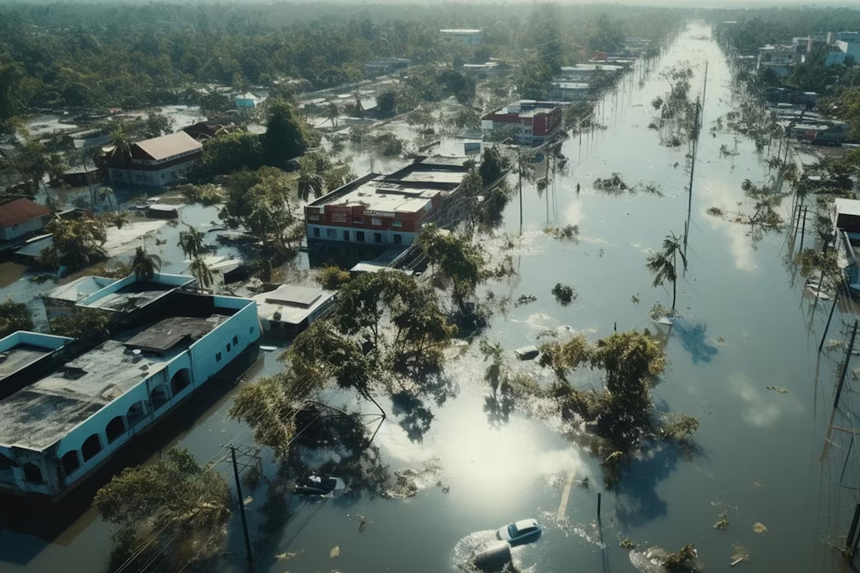In Gujarat, heavy rain has resulted in disastrous floods that have caused extensive destruction as rivers overflow, crops are ruined, and thousands of people have been homeless. The state is still on great alert as rescue activities are continuous.
What Is the Extent of the Flooding Crisis in Gujarat?
Western Indian state Gujarat has been experiencing one of its most significant flooding problems recently. Since Sunday, at least 28 people have died, and more than 24,000 people have been relocated as a result of severe and persistent rain destroying the area. As rivers and reservoirs have overflowed and water levels in several places above the danger mark, the downpour has caused extensive destruction.
Deadly Super Typhoon Ragasa Hits Taiwan, Heads for China
State officials claim that the degree of the rain has resulted in extreme floods, especially in low-lying areas. Working around the clock to evacuate residents from the most affected districts, the Indian army and national disaster response teams conduct rescue and relief activities. While boats and other rescue vehicles are being utilized to reach those caught by increasing floodwaters, helicopters have been sent to many areas to transport stranded people.
“The situation is extremely challenging, but our teams are dedicated to ensure the safety of every individual in the affected areas,” a National Disaster Response Force (NDRF) spokesman said. “We are working constantly to save lives and offer relief.”
Images from Gujarat show flooded streets, underwater homes, and overflowing rivers, transforming once-bustling towns into virtual islands. The constant rain has damaged infrastructure, making it challenging for emergency services to get to some places.
Why Has Gujarat Been Placed on High Alert?
With the India Meteorological Department (IMD) projecting continuous heavy rain over the following days, Gujarat’s situation is under great concern. Officials are preparing for more difficulties as the situation develops; certain areas of the state have gone through over 48 hours of nonstop rain.
Severe flooding is not unfamiliar in Gujarat, especially during the monsoon season, which usually runs from June to September. Similar flooding in 2017 claimed the lives of more than 200 individuals. According to a government assessment, a government’s susceptibility to floods is mainly related to its terrain. According to the research, several of Gujarat’s main rivers cross long periods of level ground before emptying into the Arabian Sea. This ground level may allow floodwaters to spread rapidly and extensively, flooding vast regions without warning.
As additional rain is expected, officials have cautioned that the present flooding might linger and increase in the following days. The state administration has instructed residents in flood-prone regions to evacuate and follow all required guidelines to guarantee their safety.
“The weather is still erratic. Hence, everyone should always be alert. An IMD official stated, “We are closely observing the matter and liaising with several agencies to offer timely assistance.”
How Have Transport and Agriculture Been Affected?
Along with endangering lives, the floods have seriously impacted ordinary Gujarati life. In several places of the state, transportation has virtually stopped. Waterlogged lines have caused 48 trains to be canceled as of Wednesday, and several roads have also become inaccessible. Many individuals have been left stranded; the disturbances to transportation are anticipated to last until water levels fall.
For Gujarat’s farmers, things have been terrible. One of the worst-affected regions, the Saurashtra area, has seen relentless rain that has severely damaged crops everywhere. Farmers are claiming significant losses, particularly in producing two of the primary commodities in the area, cotton and groundnut.
“This downpour has damaged everyone. One unhappy farmer reported that his groundnut fields are underwater and his cotton crop is ruined. “We were already facing difficulties; now this disaster has worsened things.”
Given the region’s reliance on agriculture, the disaster’s long-term consequences will affect its economy. Crop loss will affect the farmers, local markets, and the food supply.
What Lies Ahead for Gujarat?
Although the meteorological projection offers some promise, authorities remain wary. As the deep depression over the Arabian Sea approaches Pakistan progresses near Pakistan, the IMD has estimated that the heavy rains will start to tap off by September 1. Still, the situation is fragile until then.
“We expect the rain to lighten in a few days; the state is on great alert. A weather service spokesman said until then, everyone should heed official cautions, remain safe, and help rescue crews.
The people of Gujarat are left waiting for relief, hoping that the worst is passed even as rescue activities keep on and the state gets ready for more rain. However, as the state works through the aftermath of this catastrophe, recovery will be difficult. The next several days will be crucial as Gujarat tries to negotiate the storm and start to rebuild from the damage it leaves behind.








